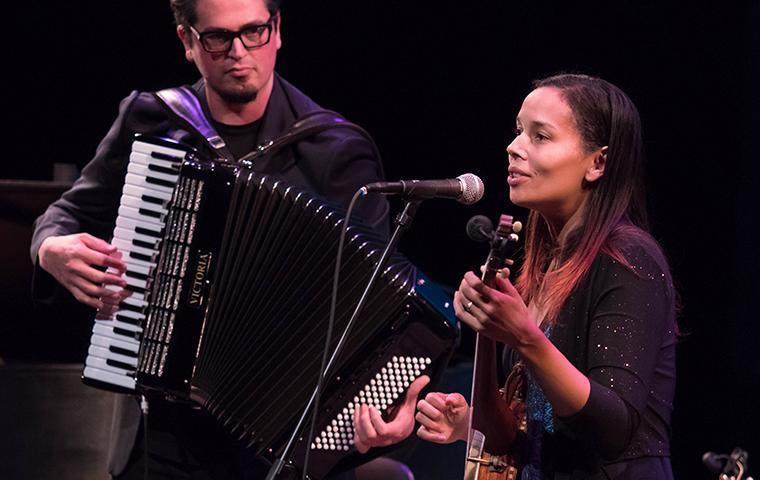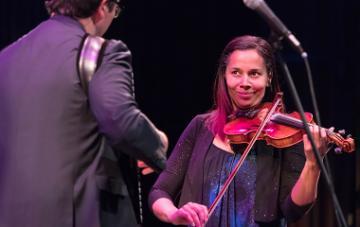
Rhiannon Giddens Resurrects the Past
Frank Sinatra Chair in the Performing Arts enthralls, educates SCU audience
In the days leading up to her powerful Friday night performance before a full house at the Louis B. Mayer Theatre, Grammy Award-winning singer and musician Rhiannon Giddens was already on campus spreading the word with Santa Clara University students, faculty, and staff about her life’s mission.
Like the painful history she has excavated over the years that inspires much of her musical storytelling, it’s complicated. And it begins with the banjo.
“My mission in life is to tell as many people as possible that the banjo is actually an African-American instrument,” the 2019-20 SCU Frank Sinatra Chair in the Performing Arts told the audience soon after she kicked off two hours of songs drawn from folk music, gospel, blue grass, Gaelic and even Italian lore as she played banjo or fiddle, while musical partner Francesco Turrisi jumped from accordion to frame drums, lute to piano.
“I didn’t know this either—I didn’t know this growing up,” said Giddens of her ancestors’ banjo backstory.
“It’s only when I started playing it that I started getting told the history, and I was like, what? WHAT? What else haven’t they told us?” added the Greensboro, N.C.-born daughter of a white father and a Black mother. “And that’s kind of what started my quest.”
It propelled her, years ago, to visit Africa and the Gambia, where she studied a pre-banjo instrument fashioned from a gourd, versions of which later made their way to America with African slaves. Eventually, Giddens’ journey led her to purchase and use a replica 1858 American minstrel-style banjo—similar to the commercial banjo hoop style we know today. By that time, it was a staple of white performers who had capitalized on the musical genre's popularity, albeit in black face and lampooning African-Americans—another shameful historic note, “and one of the reasons we don’t talk about it,” said Giddens.
For decades after, she added, minstrelsy was the most popular form of entertainment in America, what she calls “the first cultural American export.”
“So it’s kind of a big deal, and it’s shot through every aspect of American culture,” said Giddens. But much of the music was derived from those old-time African-American banjo players and Black string bands who are often forgotten and overlooked, as she clarified in the recent PBS Ken Burns Country Music docuseries.
Not surprisingly, some of the most haunting songs Giddens performed Friday night with Turrisi are rooted in racism.
“At the Purchaser’s Option” takes its cue from an historic advertisement for a young Black female slave for sale, and her nine-month-old baby, who was, the printed ad noted, “at the purchaser’s option.”
I've got a babe but shall I keep him
’Twill come the day when I'll be weepin'
But how can I love him any less
This little babe upon my breast
You can take my body
You can take my bones
You can take my blood
But not my soul
You can take my body
You can take my bones
You can take my blood
But not my soul
“I thought about the courage it would take to get up, day after day,” Giddens told the audience of her songwriting inspiration, “without having any part of your life under your own control, not even your children.”

Rhiannon Giddens plays fiddle next to accordion player and musical partner Francesco Turrisi.
“Ten Thousand Voices” traces the story of the trans-Saharan Arabic slave trade in the 500 and 600 A.D. centuries that ensnared many talented female musicians and their renowned books of repertoire—some reportedly containing 10,000 verses—sold along with them.
“Yeah,” Giddens quipped before taking up the mournful verses she had conjured, “I’m the girl who’s fun at parties.”
Her renderings of other tales of melancholy were elegant, from “Wayfaring Stranger,” an American folk and gospel song about the end of a protagonist’s life, to forceful, as in “Little Margaret,” a heart-pounding traditional English ballad about an anguished ghost visiting her beloved at his marriage bed, sealing his fate. (Both songs are included on the duo’s latest album, There is No Other.)
But Giddens’ glorious voice and deftness with banjo and fiddle, together with Turrisi’s varied instruments, lit up brighter, faster-paced jigs and toe-tapping tempos including the mostly instrumental “Briggs’ Foro,” and “Pizzica di San Vito,” the latter a tambourine-based piece inspired by Turrisi’s Southern Italian heritage, and sung in Italian by Giddens.
Turrisi’s own global insights about the accordian, and the history of the frame drum's Central Asian and Mediterranean influences, offered the audience some lighthearted segues, as did the duo’s gentle banter often while preparing for their next song.
Shortly before Giddens launched into the Irish classic “Molly Branigan,” for example, Turrisi tickled the crowd when he declared that “the song is OK ... but what comes before the song is possibly the pinnacle of this evening.
“Arguably,” he continued in jest as his onlookers chuckled, “the reason why you all came out tonight is the tambourine solo. Because my mission tonight is to convince you—to make you walk out of here knowing and believing—that the tambourine is a serious and respectable instrument.”
More often, the grinning Turrisi confessed, “I get the case out, and they (audience) go ugh.”
The Frank Sinatra Chair in the Performing Arts, established in 1980, is hosted by the Center for the Arts and Humanities in the College of Arts and Sciences. The residency seeks to feature performance artists with a strong physical presence on campus, who live out the University’s fundamental values to teach, learn, create and study across disciplines to advance human understanding. Giddens will return to campus in early 2020 to give other performances on campus, work with students, and engage with the University community on special projects.
Rhiannon Giddens playing her banjo on stage Friday night at SCU’s Mayer Theatre with Francesco Turrisi on accordion. Photos by Charles Barry.